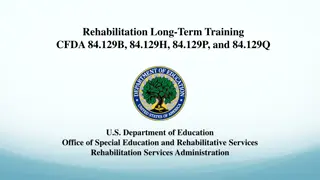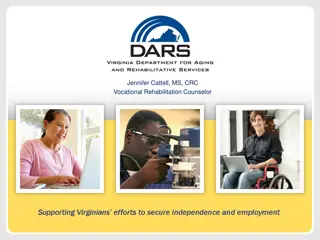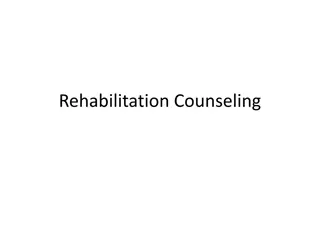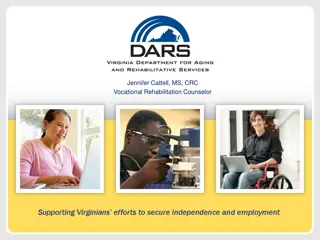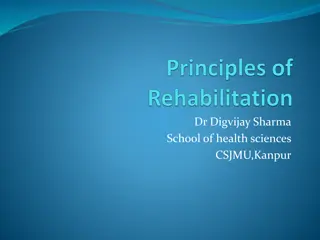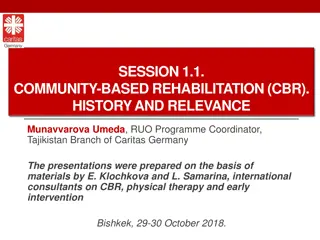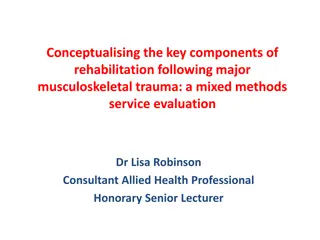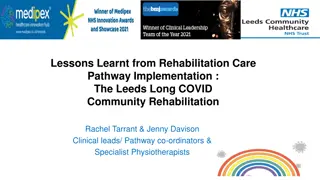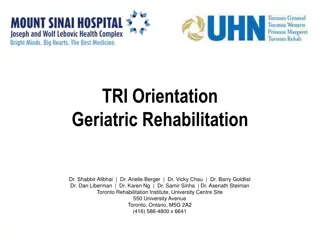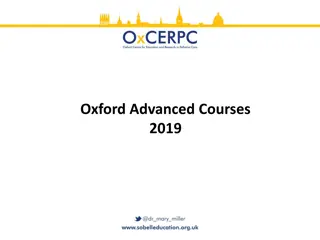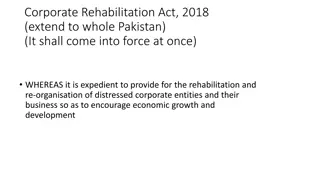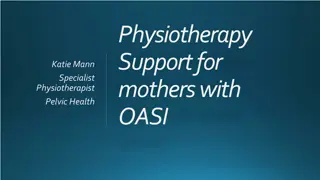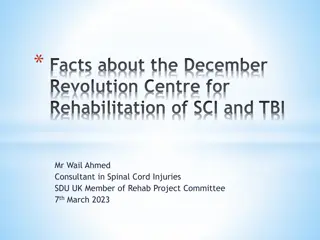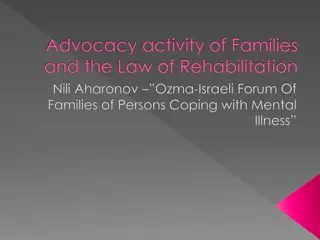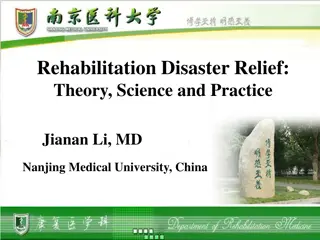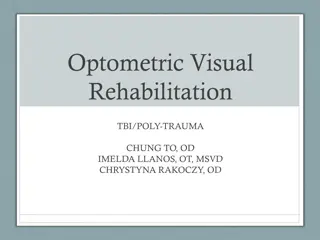Understanding Rehabilitation and Health According to WHO
Rehabilitation focuses on restoring abilities for daily life through medical, social, and vocational measures, making life more meaningful. Health, as per WHO, encompasses physical, mental, and social well-being. Rehabilitation is crucial for people facing various challenges such as injuries, trauma, disabilities, and chronic conditions.
Download Presentation

Please find below an Image/Link to download the presentation.
The content on the website is provided AS IS for your information and personal use only. It may not be sold, licensed, or shared on other websites without obtaining consent from the author. Download presentation by click this link. If you encounter any issues during the download, it is possible that the publisher has removed the file from their server.
E N D
Presentation Transcript
DR. DIGVIJAY SHARMA UIHS CSJMU, KANPUR
The word rehabilitation comes from latin prefix re- meaning again fit. When something falls in to disrepair and needs to be restored to a better condition , it needs rehabilitation. Rehabilitation is a care that can help you get back, keep , or improve abilities that you needs for daily life. These abilities may be physical, mental and cognitive. Rehabilitation can improve your daily life and functioning. again and habitare meaning make make fit.
Rehabilitation focuses on the existing capacities of the handicapped optimum level of his or her functional ability by the combined and coordinated use of medical, social, educational and vocational measures makes life for the handicapped individual more meaningful, more productive and therefore adds more life to years. Rehabilitation may be medical or Medical rehabilitation and paramedical skills to help treat the patient. Rehabilitation focuses on the existing capacities of the handicapped person,and optimum level of his or her functional ability by the combined and coordinated use of medical, social, educational and vocational measures. It person,and brings him to the brings him to the adds more life to years. sociovocational. . Rehabilitation may be medical or sociovocational Medical rehabilitation is the utilisation of medical
DEFINITION OF HEALTH ACCORDING TO WHO Health is a complete physical, mental and social well-being and not merely the absence of disease and infirmity. DEFINITION OF REHABILITATION ACCORDING TO WHO Rehabilitation is a set of measures that assist individuals, who experience or likely to experience disability , to achieve and maintain optimum functioning in interaction with their environments. DEFINITION OF HEALTH ACCORDING TO WHO DEFINITION OF REHABILITATION ACCORDING TO WHO - -
Rehabilitation is for people who have lost abilities that they need for daily life . Injuries and trauma including burns, fractures, traumatic brain injury, spinal cord injuries. Stroke Severe infection Certain birth defects and genetic disorders Developmental disabilities Major surgery Side effects from medical treatment such as form cancer treatments. Chronic pain including back and neck pain Intesive care unit patients
Handicapped individuals have problems with 1. Orientation: orientation to surroundings would hamper his activities of daily living like feeding or toileting. 2. Physical independence: person that he reduces dependence on the people taking care of him. 3. Mobility: severely hamper mobility and thus even day to day tasks like moving around in the house can become very challenging. 4. Occupational integration: job. 5.Social integration: made to integrate handicapped people into society, and not isolate them. 6.Economic self livelihood. Orientation: For a person with head injury or cerebral palsy, the 2. Physical independence: It is the prayer of every handicapped Mobility: Poliomyelitis and paraplegia are conditions that Occupational integration: Training and placement in a suitable 5.Social integration: No man is an island, and attempts must be 6.Economic self- -sufficiency: sufficiency: The job must ensure a means of
Preventive medicine prevented from occurring, by avoiding the interaction between agent, host and environment. Curative medicine to cure the disease. Most doctors practice curative medicine. However there are several conditions like rheumatoid arthritis which has no cure, and others, like poliomyelitis in which the agent causing the disease has been eliminated from the host, but residual effects like paralysis still persist. Therefore, there is a need for a third phase, namely rehabilitation, which is not just medical but also a social responsibility. Preventive medicine is the first phase where a disease is Curative medicine- -the second phase focuses on attempting
Rehabilitation medicine medical care; after preventive and curative. It is concerned with the improvement of function through the diagnosis and treatment of health conditions , reducing impairments, and preventing or treating complications of persons with disability. There are therefore two aspects to rehabilitation- 1.Medical Rehabilitation 2.Sociovocational Rehabilitation Rehabilitation medicine is the third phase of
Importance of Medical and sociovocational rehabilitation is the responsibility of a team of professionals headed by a Physiatrist, the key doctor in the guidance of the rehabilitation program. PHYSIATRISTS medicine and rehabilitation . Commom problems which result in residual disability needing the expertise of a physiatrists are stroke ,neuromuscular disorders, musculoskeletal disorders, cardiopulmonary diseases,arthritis and others. The physiatrists can help to improve a persons functional capabilities by a medical treatment . The professionals such as physical, occupational , speech therapist, psychological, social nursing , prosthesis, orthotics, engineering and vocational service. These professionals combine and coordinate to uplift the handicapped. The fundamental goal of rehabilitation is to add life to years , not years to life. Importance of Physiatry Physiatry : THE PHYSIATRIST : THE PHYSIATRIST PHYSIATRISTS are physicians who specialised in physical The fundamental goal of rehabilitation is to add life to years , not years to life.
The importance of functional independence, without which the patient remains partially dependent throughout his life. The importance of physiatry functional independence, without which the patient remains partially dependent throughout his life. physiatry and rehabilitation services ensures and rehabilitation services ensures
In the prepathogenesis period, the interaction between host agent and environment causes disease, triangle, the traditional model for infectious disease] which passes from the subclinical stage to the clinical manifestation of disease. , the interaction between host agent and environment causes disease,[this is called epidemiological triad or
Prevention of disability does not start only at birth, at the onset of disease or after a primary disability occurs. Sometimes it may be done even before the child is born, by anticipating disability due to genetic defects or blood group incompatibility and can be prevented by means of genetic counseling. For example- In Duchennes muscular dystrophy, it is possible to counsel the parents on having another child who might later display the symptoms of the disease. It therefore follows with a fall in mortality levels there is a rise in morbidity levels. Rehabilitation deals with morbidity , it deals with quality of life. a fall in mortality levels there is a rise in morbidity levels. Rehabilitation deals with morbidity , it deals with quality of life.
Any health care that tries to halt a persons slide down the slope of the health status scale is termed preventive health care and any attempt to push it up towards the peak, i.e. optimum health, is called therapeutic health care. This total spectrum is classified into three levels of prevention by the World Health Organization.
It is explained as a measure taken before the onset of any disease, e.g. immunization against childhood infections or chlorination of drinking water. It is designed to promote general health and improve the quality of life. It incorporates health education for bringing about awareness of health problems before it occurs. This is similar to the first phase of medicine, i.e. preventive medicine. preventive medicine.
It is a measure taken to arrest the progression of a disease while it is still in the early asymptomatic stage of the disease. It involves early diagnosis and immediate treatment, e.g. ergonomic intervention to prevent clinical symptoms in a patient with spondylosis.
It is explained as a measure taken to minimize the consequences of a disease or injury once it has become clinically manifested, e.g. prevention of pressure sores in a paraplegic by turning the patient over regularly. Tertiary prevention is an integral part of Rehabilitation Medicine. . Tertiary prevention is an integral part of Rehabilitation Medicine.
Sociovocational rehabilitation is a team effort which aims at providing the disabled a vocation, a barrier free place to live and the right social environment to reduce his handicap. At the heart of vocational rehabilitation ,it is the concept of the right to work. It empowers persons not just economically but in a more basic and meaningful sense. It makes a person stand on his on legs. It does not bind him to a job, it set him free. right to work. set him free.
The catchword today is empathy not sympathy. the person with disability are giving throughout the world is please accept us as we are. There are several shining examples for this- STEPHEN HAWKINS Gross motor disabiity HELEN KELLER- Visual and hearing impairment BHAKT SURDAS AND JOHN MILTON Visually impaired. FRENKELIN D. ROOSEVELT- Guillain-Barre syndrome. empathy not sympathy. In other words , the message that please accept us as we are.
The passing of the American with act of the disabled in that country in India. In India, the act passed is the [PWD] People with disabilities Act 1995. Rehabilitaton by parliament in 1992 and it become a statutory body in 1993. the American with disabilties disabilties act [ADA] in 1991 was a landmark in the life [PWD] People with disabilities Act 1995. Rehabilitaton council of India [RCI] Act council of India [RCI] Act passed
The word therapy comes from ancient hebrew word refua Thousands of year ago the ancient Cong Greek physician elaborate system of gymnastic exercise. Roman physician Galen to rehabilitate. hebrew refua [healing]. the ancient chinese chinese Cong fu Greek physician Herodicus fu- - a movement therapy to relief pain. Herodicus describe an Roman physician Galen describe intervention
The philosopher physician Maimonides emphasized principle of healthy exercise and diet. Physician art of Gymnastic. Niels human motion. Joseph Clement as an alternate from bed rest for patient recovering from surgery, neurological condition, recuperating after strokes. Fulgence neuromuscular re-education. philosopher physician Maimonides Physician Mercurialis Mercurialis promote gymnastic, The Niels Stensons Stensons explored the biomechanics of Joseph Clement Tissot Tissot promoted the value of Fulgence Raymond Raymond proposed the concept of
THANK YOU.. THANK YOU ..


